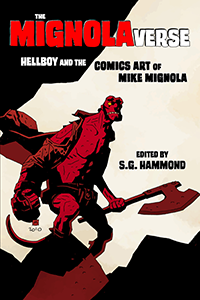The title of Lady Killer, by Joelle Jones and available from Dark Horse Comics, sort of says it all. This is a comic about Josie Schuller, a killer who stabs, punches, kicks and spins without getting (too many) runs in her nylons. Hitting notes that are reminiscent of Kill Bill, the book is about an assassin whose cover is as an early 1960s housewife (think Betty Draper), with her true profession unbeknownst even to her clean-cut sweater-wearing husband and apple-cheeked children (although her German mother-in-law has suspicions). She has a mysterious male handler who looks like he just stepped out of a Bond movie, who assigns her missions that range from posing an Avon lady to posing a Playboy Bunny (and she’s convincing in either guise).
Lady Killer is nominated for its Eisner in the category of Best Limited Series, so we won’t spoil too much of the actual plot (all five issues are available in a TPB). It’s a self-contained story, but it’s certainly not out of the question that it could be continued at a later time. The story, by Joelle Jones and Jamie S. Rich, takes us through a fairly familiar crime story arc, with Josie enjoying the double life she’s leading (housewife/killer), but becoming increasingly disaffected with having to balance work and family, and is looking for a way out. Her superiors, of course, worry that she’s just planning to “go rogue”, because she has such incredible skills. She isn’t just any old killer: she’s the best. The plot then takes us through the usual ups and downs of secret machinations and betrayals, ending with a great, tense sequence set at the Seattle World’s Fair and involving a plot against President Kennedy. The fun of the book is simply revelling in the witty dialogue, great fight scenes and the general attitude of the lead character. She’s no shrinking violent, but she’s also no hardened killer: she’s a fully realized female action hero who mostly avoids cliche. That’s rare enough (alas) to make this a remarkable comic.
Josie and her suave James Bond-y handler
The art, by Joelle Jones, with colours by Laura Allred, is the comic’s not-so-secret weapon. Deliberately aping that pulpy late-40s style, it’s a peek into what comics might have looked like in the early 60s, had there been no comics code. The men are mostly portrayed as clueless, evil or dissolute morons who paw at women like sloppy dogs, but that’s all part of the perspective the book takes, namely Josie’s. Jones, on the other hand, draws women as bombshells, but bombshells with muscles. Josie’s physique is sexy, to be sure, but she also has “guns” and a fierce, angular face and ferocious green eyes that seem to just beg for the chance to put the proverbial slap down. Her muscular, broad shoulders and thighs give us a relatively unusual take on the objectified comics “woman” – one that projects strength and discipline, as well as intelligence and eroticism. Josie has the whole package, and if the book isn’t exactly flattering in its portrayal of men, that seems only fair, especially when considered historically.
Lady Killer also makes great use of its period design, and not just in the clothes, but in that modernist, early-1960s architecture, with its boxy furniture and grid-like room design. Jones lovingly re-creates the classic suburban bungalow, complete with concrete porch and tiki torches, and throws in wonderful period grace notes such a heavily pregnant neighbour casually smoking cigarettes while the kids play in the yard.
The book doesn’t make the mistake of making Josie’s home life seem horrible or intolerable, but certainly boring (at times) and she feels neglected by her husband, who looks forward to her going away on her little “trips”. Josie goes through the trouble of coming up with elaborate excuses to not be present at home, but her husband simply doesn’t seem to care, and says he’ll just “work on the truck” when she’s away. Their young daughters are loveable enough, not delinquents, and generally adore their mom. So, the choice of the life of a killer vs the life of stable suburban bliss is given some dramatic heft. It would have been easy (and cliched) for this book to go the whole route of “exposing” mid-century America’s social hypocrisies and faults, but instead Joelle Jones gives us a relatively accurate and sympathetic (without being too nostalgic) peek into a different age, and portrays it without any hint of hipster snark.
Lady Killer takes it place along some of the very best comics in the industry with its Eisner nomination, and for its pulpy style, appealing characters and dynamic, fantastic art, it deserves all the readership it can get.




















































You made a lot of great points that I didn’t think about when I wrote reviews about these five issues, but I don’t agree with the idea that the art is “fantastic.” For example the first issue has a kill that looks ineffectually done due to how the weapon and her arm are positioned.